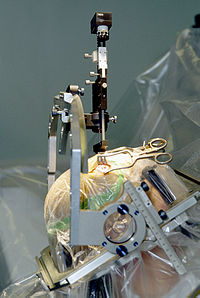
Photo from wikipedia
In this historical vignette, the authors discuss the prevention of surgical site infections (SSIs) after brain surgery from the prehistoric period to the present. Although the mechanism for infection was… Click to show full abstract
In this historical vignette, the authors discuss the prevention of surgical site infections (SSIs) after brain surgery from the prehistoric period to the present. Although the mechanism for infection was not fully understood until the 19th century, records demonstrate that as early as 10,000 bc, practitioners used gold, a biocidal material, for cranioplasties and attempted to approximate wounds by tying a patient's hair across the incision. Written records from the Egyptian and Babylonian period depict the process of soaking head dressings in alcohol, an antibacterial agent. In the Greek and Early Byzantine period, Hippocrates argued against the formation of pus in wounds and continued to champion the use of wine in wound management. In the 16th century, intracranial silver drains were first utilized in an effort to prevent postoperative infections. The turning point of SSI prevention was in 1867, when Joseph Lister illustrated the connection between Louis Pasteur's discovery of the fermentation process and the suppuration of wounds. Today, there are ongoing investigations and debates about the optimal techniques to prevent SSI after brain surgery. Although tremendous progress in the field of SSI prevention since the prehistoric period has been made, SSI continues to affect morbidity and mortality after brain surgery.
Journal Title: Neurosurgical focus
Year Published: 2019
Link to full text (if available)
Share on Social Media: Sign Up to like & get
recommendations!